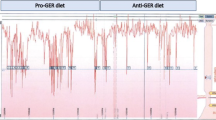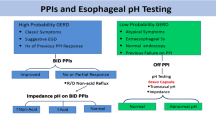Abstract
Ambulatory 24-hour esophageal pH measurement is the standard for detecting abnormal esophageal acid exposure (AEAE), but it has a false negative rate of 15% to 30%. Wireless 48-hour pH monitoring (Bravo; Medtronic, Shoreview, MN) may allow more accurate detection of AEAE versus 24-hour pH monitoring. Forty-eight-hour wireless data were reviewed from 209 patients at three different tertiary care referral centers between 2003 and 2005. Manometric or endoscopic determination of the lower esophageal sphincter helped place the Bravo probe 5 to 6 cm above the lower esophageal sphincter. A total of 190 studies in 186 patients had sufficiently accurate data. There were 114 women and 72 men with an average age of 51 years. AEAE was defined by a Johnson-DeMeester score greater than 14.7 and was obtained in 115 of 190 studies (61%). Only 64 of 115 patients (56%) demonstrated AEAE for both days of the study, whereas 51 of 115 patients (44%) demonstrated AEAE in a single 24-hour period. There was no difference in the prevalence of AEAE on day 1 versus day 2 only (26% vs. 18%, P = .26). Compared with 24-hour alone data, 48-hour data showed 22% more patients with AEAE. Frequent day-to-day variability in patients with AEAE may be missed by a single 24-hour pH test. Fortyeight-hour pH testing may increase detection accuracy and sensitivity for AEAE by as much as 22%.
Similar content being viewed by others
References
Jamieson JR, Stein HJ, DeMeester TR, et al. Ambulatory 24-h esophageal pH monitoring: normal values, optimal thresholds, specificity, sensitivity, and reproducibility. Am J Gastroenterol 1992;87:1102–1111.
Fuchs KH, DeMeester TR, Albertucci M. Specificity and sensitivity of objective diagnosis of gastroesophageal reflux disease. Surgery 1987;102:575–580.
Mearin F, Balboa A, Dot J, et al. How standard is a standard day during a standard ambulatory 24-hour esophageal pH monitoring? Scand J Gastroenterol 1998;33:583–585.
Fass R, Hell R, Sampliner RE, et al. Effect of ambulatory 24-hour esophageal pH monitoring on reflux-provoking activities. Dig Dis Sci 1999;44:2263–2269.
Wiener GJ, Morgan TM, Copper JB, et al. Ambulatory 24-hour esophageal pH monitoring. Reproducibility and variability of pH parameters. Dig Dis Sci 1988;33:1127–1133.
Prakash C, Clouse RE. Value of extended recording time with wireless pH monitoring in evaluating gastroesophageal reflux disease. Clin Gatroenterol Hepatol 2005;3:329–334.
Johnson LF, DeMeester TR. Development of the 24-hour intraesophageal pH monitoring composite scoring system. J Clin Gastroenterol 1986;8(Suppl:1):52–58.
Antoniazzi L, Hua HT, Streets C, et al. Comparison of normal values obtained with the BravoTM, a catheter-free system, and conventional esophageal pH monitoring. Gastroenterology 2002;122:A338.
Pandolfino JE, Bianchi LK, Lee TJ, et al. Esophagogastric junction morphology predicts susceptibility to exercise-induced reflux. Am J Gastroenterol 2004;99:1430–1436.
Streets CG, DeMeester TR. Ambulatory 24-hour esophageal pH monitoring: why, when, and what to do. J Clin Gastroenterol 2003;37:14–22.
Franzen T, Grahn LT. Reliability of 24-hour oesophageal pH monitoring under standardized conditions. Scand J Gastroenterol 2002;37:6–8.
Pandolfino JE, Richter JE, Ours T, et al. Ambulatory esophageal pH monitoring using a wireless system. Am J Gastroenterol 2003;98:740–749.
Bruley des Varannes S, Mion F, Ducrotte P, et al. Simultaneous recordings of oesophageal acid exposure with conventional pH monitoring and a wireless system (Bravo). Gut 2005 [Epub ahead of print].
Author information
Authors and Affiliations
Rights and permissions
About this article
Cite this article
Tseng, D., Rizvi, A.Z., Fennerty, M.B. et al. Forty-eight-hour ph monitoring increases sensitivity in detecting abnormal esophageal acid exposure. J Gastrointest Surg 9, 1043–1052 (2005). https://doi.org/10.1016/j.gassur.2005.07.011
Issue Date:
DOI: https://doi.org/10.1016/j.gassur.2005.07.011




